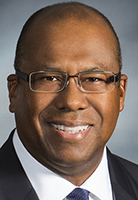
President's Corner
‘It Used To Be a Good School’
By Alton L. Frailey/
School Administrator, January 2017

How many times have you heard the statement, “That used to be a good school”? I’ve heard that declaration many times throughout my career, and each time I wondered what the speaker meant.
How can a place that was once considered good become not-so-good? What are the perceived and real causes of the change in standing? What are the indicators? What changed? When and how did it happen?
Why did it happen?
Agreeing about the characteristics of a good school isn’t necessarily an easy task. For some, the sole indicator may be test scores — yes, there are those who still judge schools by test scores. For others, the criteria may be how the school meets the needs of the whole child, whether it provides a vibrant curriculum and addresses both the physical and emotional health of students.
Despite their experience and expertise, school leaders must resist the temptation to determine alone what constitutes a good school, to leave the community on the periphery. The schools belong to the community, and as difficult as it may be, it’s important that the school and community agree about what’s important.
The community must define what it values and what it expects of its schools. Then, working together, the school and the community can articulate those values clearly, succinctly and concretely. With commitment and support from both sides, the school and community can create systems and processes by which these values are disseminated, reinforced and evaluated.
The focus then turns to maintaining the good school characteristics. In his book
The Tipping Point, Malcom Gladwell defines the “magic moment when an idea, trend or social behavior crosses a threshold, tips and spreads like wildfire.” This can happen with an epidemic, a sports team, a fashion trend or the community’s attitude about a school or school district.
The challenge with keeping a good school good is understanding when, how and why forces begin moving toward that threshold that tips the community’s perception about how the school is doing. This shift typically happens over time. Usually critical points are missed or ignored. Sometimes people move into a community where schools have a reputation of being good schools — but they do not bring with them the same values, attitudes and behaviors that contributed to and sustained the good community and schools.
What options, then, does a school, school district or community have to prevent it from tipping over the threshold from good to bad? This is when a sense of shared ownership and responsibility, as well as great and purpose-filled conversations and collective work, are required.
While studying systems early in my career, I became familiar with the term
tragedy of the commons. Tragedy of the commons is an economic concept that describes a situation in which individual users try to reap the greatest benefit from shared resources, letting their own self-interests get in the way of the common good. Examples include farmers whose cattle overgraze common pastures and parents who monopolize a teacher’s time during meet-the-teacher night.
Some communities collapse due to this tragedy of commons — their members do not have the sense of social responsibility to put the well-being of the community ahead of their own. However other communities use common resources prudently and, as a result, they thrive. They have managed their growth and maintained quality schools they own, support, advocate for and remain proud of.
That is a key premise of Communities 4 Schools — the importance of thriving as a community, of owning, protecting and defending its schools, students and staff. How are you creating a triumph of commons? Join me in the conversation on Twitter using the hashtag #tellyourstory.
Alton Frailey is AASA president for 2016-17. E-mail:
communities4schools@gmail.com. Twitter:
@altonfraileyC4S